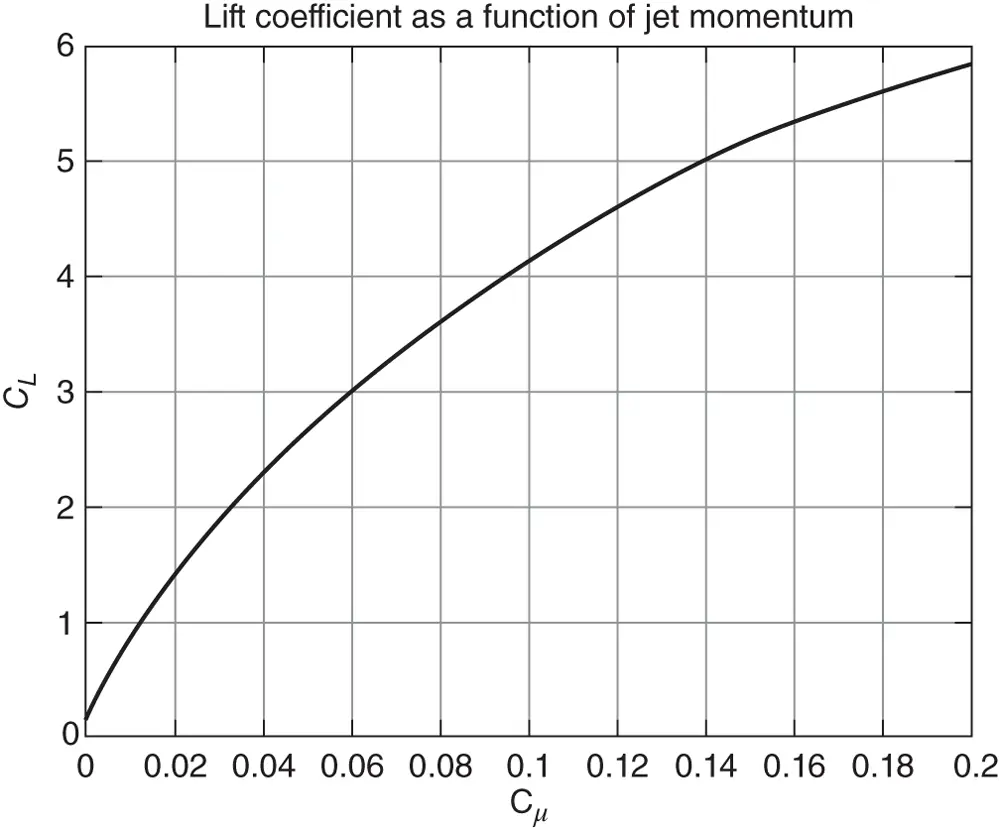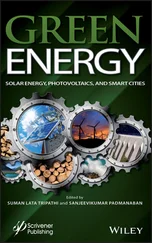
Figure 3.77 Lift coefficient vs jet momentum coefficient for jet circulation control.
These devices mimic the effect of a conventional (solid) flap but have the advantage that large rates of change of lift can be achieved very quickly by sudden changes in the jet pressure and hence momentum. The effectiveness of both in controlling circulation is due to the Coanda effect, whereby an exiting ‘wall‐jet’ sticks to a highly curved surface. In the jet flap case, the effectively ‘active’ length and curvature of the jet sheet depends on the jet momentum. In the rounded trailing edge case, the jet sticks to the highly rounded surface to a greater or lesser extent according to the jet momentum, thus exhausting from the aerofoil trailing edge at a greater or lesser angle. The resulting free jet in both cases simulates a deployed structural flap but without the need to overcome significant inertia in rapid activation. Such devices deployed along the outboard trailing edge of the blade give two advantages. They allow high lift coefficients to be obtained (not limited in the same way by separation as a solid flap) so that the blade chord may be substantially reduced to achieve the same power production. This reduces the weight of the blade and also blade loads when the parked blade is impacted by high wind gusts at large angles to the blade. Second, very rapid control is possible. However, the system has obvious disadvantages of complexity, maintenance, and cost (although less prone to problems of dirt ingress, as it is an overpressure device), the aerofoil section with the jet turned off generates higher drag than a typical ‘sharp’ trailing edge section, and there is a power requirement to provide the jet momentum. Johnson et al. (2008) give an extensive review of many of the above types of devices for blade load control.
3.19 Aerodynamic noise
3.19.1 Noise sources
Since deployment of wind turbines became widespread onshore from the1990s onwards, growing public resistance to the siting of turbines in areas close to dwellings has become a major planning issue. The two most important points of objection are normally visibility and noise. Efforts to minimise the first of these focus on detailed siting and surface appearance of the turbine, noting that there is generally a conflict between siting to reduce visibility and siting to maximise wind energy capture. The issue of noise, however, is closely related to turbine operation because the two main sources of wind turbine noise are the machinery and the blade aerodynamics. Radiated noise from wind turbine machinery (generator, gearbox, etc.) has been greatly reduced in modern wind turbine designs over the last two or three decades. Considerable attention has been paid with successful results to reducing the intensity of mechanical noise by identifying and suppressing sources of noise within the machinery and providing noise insulation. As a result, mechanical noise is now regarded as much less important than aerodynamic noise for large modern wind turbines.
This section deals with aerodynamic noise generated by the blades and methods of reducing it in the form of modifications to blade geometry and section profile. A fuller description of wind turbine noise and its measurement, prediction and assessment of environmental impact is given in Section 10.3.
Aerodynamic noise arises mainly from two sources: (i) self‐noise, which is generated by the air flow over the blades interacting locally with the blades, an effect that would occur even if the incident wind flow were to be smooth, and (ii) noise induced by the turbulence in the inflow (mainly atmospheric turbulence but also on occasion wake turbulence from upstream turbines, interacting with blades and inducing fluctuating blade loading). Aero‐acoustic noise may be either broadband or tonal. The latter is less common but more irritating if significant. There are also a number of other specific noise sources. One important example is the cyclic interaction between the blades and the tower. Although the blade passing frequency is below the audible range, the frequency content from the quasi‐impulsive interaction as a blade passes through the quite narrow influence field of the tower can in some circumstances contribute audible sound at a significant level (in addition to the unsteady loading).The effect can be made small to negligible for an upwind rotor because the aerodynamic interaction between blade and tower reduces as the square of the separation distance between the blade and the tower axis. The interaction is usually therefore minimal unless the blade passes very close to the tower. The main effect can be effectively removed by providing adequate clearance (> 1 tower diameter) through nacelle overhang and rotor tilt. It then only becomes appreciable in high wind operation when blades tend to bend towards the tower, reducing the clearance, but in this case blade noise is less of an issue because of background wind noise. Blade–tower interaction noise can be significant for downwind rotors with solid towers of non‐negligible diameter. This type of design is very uncommon, and hence this noise source has not been studied greatly. When it does occur, it can be difficult to remedy because the noise originates from the interaction of the blades passing through the tower wake, and such wakes only diffuse gradually over large distances. For the general aero‐acoustic sources present on wind turbine rotors, a very good review is given by Wagner et al. (1996).
Those noise sources that arise from unsteady incident flows inducing fluctuating forces on the turbine blades scale as the sixth power of the local inflow wind speed relative to the aerofoil section, and the noise is generally low frequency. Self‐noise that is broadband through the auditory range and usually dominates is found to depend on the relative wind speed over the blade at between the fifth and sixth power but closer to the former. Because the tip speed ratio is normally high, this relative flow speed is effectively the local blade speed, and the noise sources are therefore mainly significant over the outer 25% of the blade and when the rotor is operating. Because of the high power dependence of the radiated sound intensity, therefore, on rotor tip speed, the ‘simplest’ way to reduce aerodynamic noise radiation from a wind turbine is to run the rotor at a lower tip speed ratio. This has always been known and is a major reason why turbines with fewer than three blades are not favoured for onshore designs, since optimum tip speed ratio increases as rotor solidity decreases. But as there are efficiency constraints also on lowering tip speed ratio, a major effort continues aimed at reducing the aerodynamic blade noise sources themselves.
3.19.2 Inflow turbulence‐induced blade noise
Inflow turbulence interacts with the blades and generates noise due to the unsteady blade forces that arise as a result. This noise source is generally found to be a less strong source than the blade's self‐induced noise, although this is not always so. The only obvious method of alleviating the inflow noise is through a control system to mitigate the unsteady loading of individual blades due to the turbulence. Distributed control capable of operation at frequencies high enough to affect the audible noise spectrum is not yet a feature of wind turbines. Inflow noise intensity is mainly only at a level to be of concern in high, gusty winds where, because there is so much wind noise from other sources in the environment, the additional turbine noise is less significant. There is a long history and a great deal of theory developed for the prediction of rotor blade noise due to turbulent inflow because of its importance in noise radiation from aircraft turbojet engines and rotorcraft. The method originated by Amiet (1975) based on prediction of unsteady blade loading taking into account compressibility was originally developed for aero‐engines. It has been further developed and is still current as a prediction method for wind turbine rotors but involves fairly extensive computational effort. Moriarty et al. (2005) have produced a simpler model based on parameterised results for standard blade geometries.
Читать дальше













